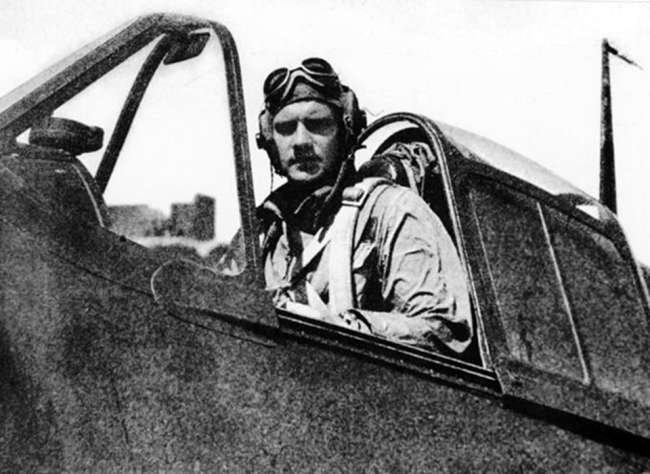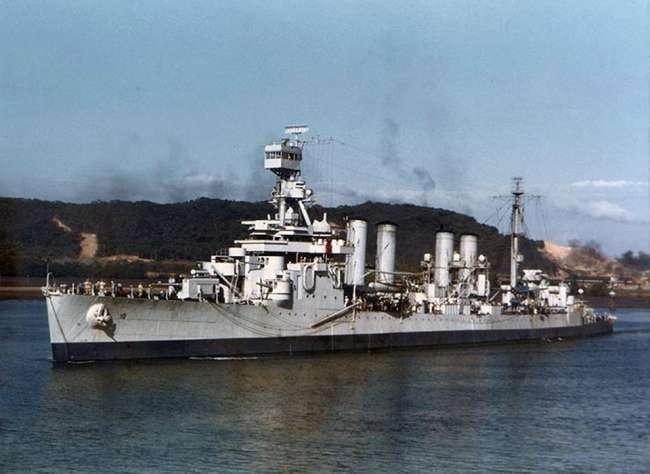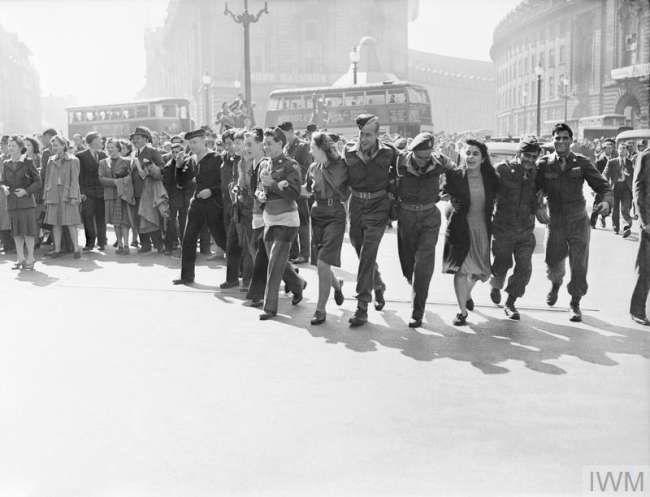For the former POWs from Stalag Luft I, the last weeks of April and the first weeks of May were chaotic and tense. Technically, they were free men. The Germans left their posts, abandoning the camp to the Americans on April 30. The Soviets arrived on May 1 and let loose with energetic abandon in the town of Barth. The barbed wire was torn down and Barth ransacked until finally martial law was declared. The Senior American Officer, fighter ace Col. “Hub” Zemke, had negotiated with German commanders for the peaceful transfer of the camp and had attempted to establish order within the American ranks until the liberated POWs could be united with US forces. But some newly-free men could not wait it out and preferred to try to make their own way back to American lines. Still many of the camp’s former forced-residents stayed on the grounds, waiting the war out in their prison camp. Initially leaving on your own was quite dangerous. The war was still going on, if wrapping up, and they were in Germany. There were snipers, mines, and the threat of being mistaken for the enemy by Americans or by Soviets. In many cases, their nationalities couldn’t be discerned from their appearance. They were a ragtag bunch wearing all kinds of cobbled-together uniforms.
Once the Soviet liberators arrived, additional worries were added to the POW collective. Would they be taken to Siberia? Would they be used as pawns? Would they be allowed to leave? The language barrier was also a bit problematic, but sign language helped, as did two very commonly used words, “Amerikanski, Tovarish” (American, Comrade.) But the experiences of the two nations and the countenance of their combatants were quite different. The Soviets could be brutal in dealing with the German civilian population. Many of them had fought their way to Barth over years, experiencing the war in all of its brutal aspects since long before Stalag Luft I existed. One POW recalled commenting to a Soviet soldier that he liked a German civilian’s boots. The soldier shot the German on the spot and ordered the American to take the boots. This kind of behavior was shocking to many of the former prisoners of war, who had been treated relatively humanely by the Germans according to the rules of the Geneva Convention. The Soviets and the Germans had no such agreement. There were tremendous casualties on both sides. The Soviet POW death rate among the Germans was 60 percent, compared with a one percent death rate among American POWs held by the Germans.
So where did that leave the Americans? The rumor mill was very strong, as it was in the POW days. It was thought that the Soviets wanted to repatriate the American POWs through the Russian Black Sea port of Odessa, rather than through France. This caused some anxiety because it meant a longer journey home, but also because no one wanted to go to Russia in the hands of the Russians. According to an account from former POW Red McCrocklin, who with his friend Dick Terrell, called Stalag Luft I home, they considered the Russians “Allies” but not “friends.”
Col. Zemke had sent his British counterpart, RAF Group Captain Weir to intersect with Field Marshal Montgomery and to advocate for a mission to unite the POWs with their countrymen. Reportedly Montgomery met with Soviet commander Marshal Rokossovsky to discuss the men of Stalag Luft I as well. When Weir returned to the camp, he reported that plans were underway for the 8th Air Force to swoop in and fly them out. On May 5, the first American officers showed up in the camp, along with three Soviet officers, including Marshal Rokossovsky. But patience after waiting so long for freedom was not always in reserve. Many didn’t believe in an expeditious plan, so they ventured off anyway, alone or in small groups. But the majority of the Allied prisoners in the camp (nearly 9,000) remained in place for the weeks following liberation, then V-E Day, and into the third week in May.
While waiting, the former POWs annexed a nearby German Flak school, utilizing any furniture or goods they could manage. They were visited by a Russian USO troupe and took in a performance which included Russian music and a newsreel viewing of the Yalta Conference. The camp was so far north, it was still broad daylight at 10pm, making for extremely long days. Col. Zemke began to threaten anyone who abandoned the camp with Dishonorable Discharge. The MP force even had to reestablish the “cooler,” to forcibly restrain those who were rowdy or who were trying to break free. Some of the men visited a nearby slave labor camp, a sub-camp of Ravensbruck, where they witnessed evidence of some of the deepest miseries enacted by the Nazis.
Back at American air bases in England planning was taking place for a rescue mission of sorts. The flight to Barth would be very different for these crews. They were flying singly, not in formations or in groups, as they had in combat just two weeks earlier. They were to keep under 10,000 feet so they wouldn’t need oxygen and they wouldn’t have a chance to refuel, so they needed to conserve gas. Normally they flew with a crew of 10, but this mission was carried out by crews of five (pilot, copilot, navigator, radio man, and flight engineer.) All unnecessary equipment and armament was removed and the bomb bays were covered over with plywood, making room for 25-30 POW passengers. The pilots were instructed to not even turn off the engines. They were to fly at one or two minute intervals from each other, more or less in a straight line. They were to hit the ground, taxi slowly to a designated area, load up, and take off. The whole operation was to be carried out very quickly and calmly.
When pilots and navigators reported to their orderly rooms in Bassingbourn, some expected they were going to be briefed on the mission home, but instead they were told of the POWs plight. According to pilot Raymond Darling, the briefing officer received applause, unheard of at mission briefings, when he said, “The Russians don’t seem to want to cooperate in releasing our American airmen POWs, so we’re going in and getting them. If the Russians don’t like what we’re doing, then it’s just tough shit.”
In Barth, the Americans kept busy preparing for the arrival of their lifts home. There was a small training field three miles from the camp, Barth Airdrome, which had a narrow runway. Work teams went out to clear the runway of mines and obstacles. An advance team arrived from England in a B-17 carrying General Bill Gross, Commander of the 1st Combat Wing, in charge of the operation. The team constructed an improvised radio tower using a generator and the B-17 radio equipment. This tower would be put to work over the next three days, receiving and dispatching the full group of rescue planes. Shipping rosters for the passengers were also prepared and then the all clear was given.
The first planes arrived in Barth on May 12 and evacuated the first load of men. Dick Terrell’s journal entry that day read, “Got packed this morning. First Kriegies [short for Kriegsgefangener or German for POW] left today. The sick and the English, over 900 of them. We were on patrol duty in town. Heard rest of us are supposed to go tomorrow.”
The next day, Sunday, May 13, was Mother’s Day. Former POW Don Freer from the 91st Bombardment Group later reported, “I will never forget the thrill and joy of marching out of Stalag Luft I to the airfield at Barth and seeing the 91st BG aircraft waiting to take us home.” The flights were extremely memorable for both the passengers and the crew. One of those from the evacuation crew, 91st Bombardment Group navigator George Jacobs told author John Howland, “I consider it one of the most memorable days of my life!” Flying over former “Flak Alleys” and “Flak Valleys,” crews now encountered peaceful, silent, but often devastated scenes. Jacobs recounted, “We got outside and welcomed the group under the wing of our plane. We said, ‘Guys you’re on your way home.' We shook each hand as they got into the plane.”
Many of the former POWs had been airmen themselves, some from the 91st Bombardment Group, although it was perhaps years since they had been in the air. Some were reluctant to fly again, given the last time they were in the air resulted in captivity, trauma, and in many instances, death. But there was a cheer and clapping as the plane soared away from Barth and they left the prison camp behind. Former POW Oscar Richard said, “The group I was in boarded a bomber about one o’clock that afternoon. I grabbed a spot near one of the waist windows so I could see Germany once more from the air.”
Many former POWs were amazed at the B-17G which became prevalent late in 1943, after many of the POWs had already been grounded. On the way to France from Barth, the “evacuation crews” conducted tours of their aircraft, showing off newer features like the GEE box, the “automatic navigator.” Some of the POWs were too weak to react or were in a state of disbelief that they were actually headed home. Others pointed out targets they had hit or the spots where they had been shot down.
When the POW-laden planes landed, there were cheers again. Most American POWs were dropped off at Le Havre. The next part of their waiting would commence there, at Camp Lucky Strike, one of the large staging areas through which most would return home. The British POWs completed the trip with the 8th Air Force fliers and were flown back to the bases in Great Britain.
The last former prisoner to board a plane out of the camp was Col. Hub Zemke, who was personally responsible for a low cost of human life at Stalag Luft I in the waning days of the war.
Parts of the evacuation were filmed and can be viewed today on Youtube, including scenes with aces Col. Hub Zemke and Col. Gabby Gabreski. The Museum’s Digital Collections include several interviews with POWs from Stalag Luft I including John Sacks who describes liberation and Operation Revival.
“We said, ‘Guys you’re on your way home’. We shook each hand as they got into the plane.”
George Jacobs, 91st Bombardment Group navigator
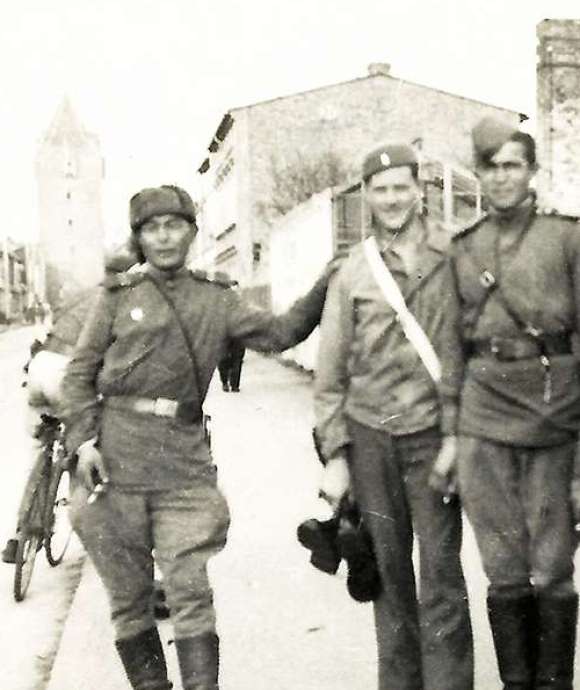
The Liberation of Stalag Luft I
When POWs awoke at Stalag Luft I on May 1, 1945, the German guards had disappeared and a hand sewn Stars and Stripes replaced the swastika on the flagpole. The Red Army arrived a day later.
This article is part of an ongoing series commemorating the 75th anniversary of the end of World War II made possible by Bank of America.
Kim Guise
Kimberly Guise holds a BA in German and Judaic Studies from the University of Massachusetts Amherst. She also studied at the Universität Freiburg in Germany and holds a masters in Library and Information Science (MLIS) from Louisiana State University. Kim is fluent in German, reads Yiddish, and specializes in the American prisoner-of-war experience in World War II.
Cite this article:
MLA Citation:
APA Citation:
Chicago Style Citation:
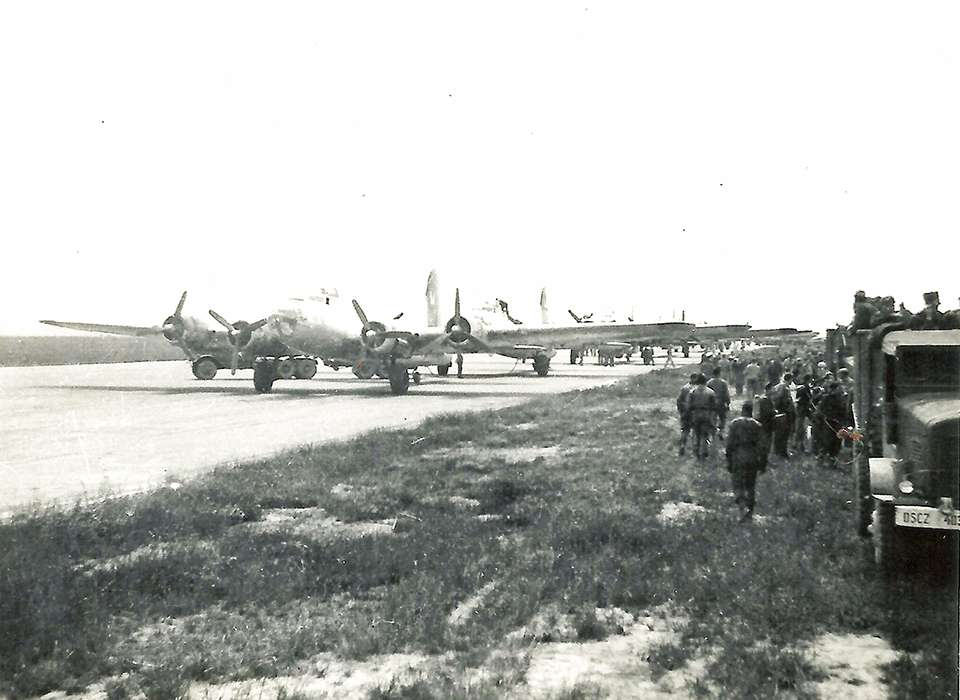
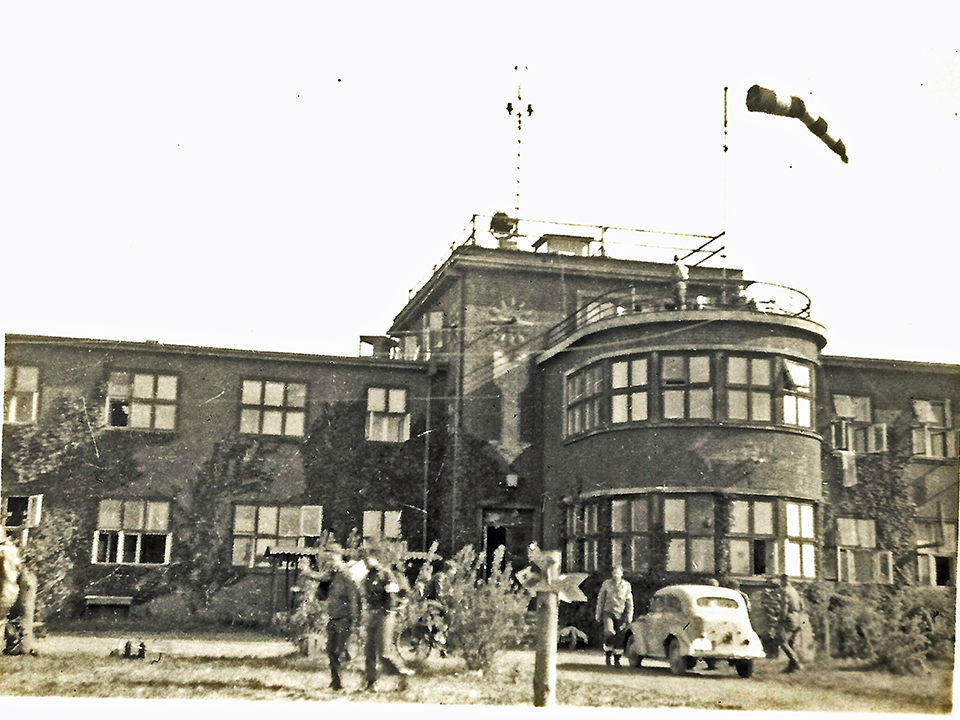
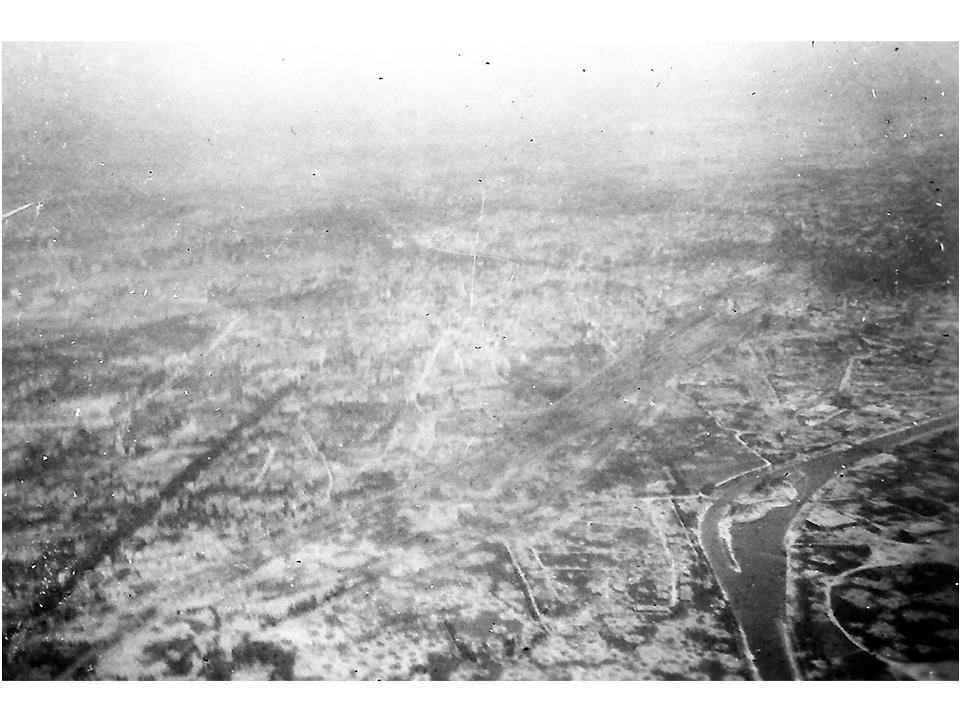
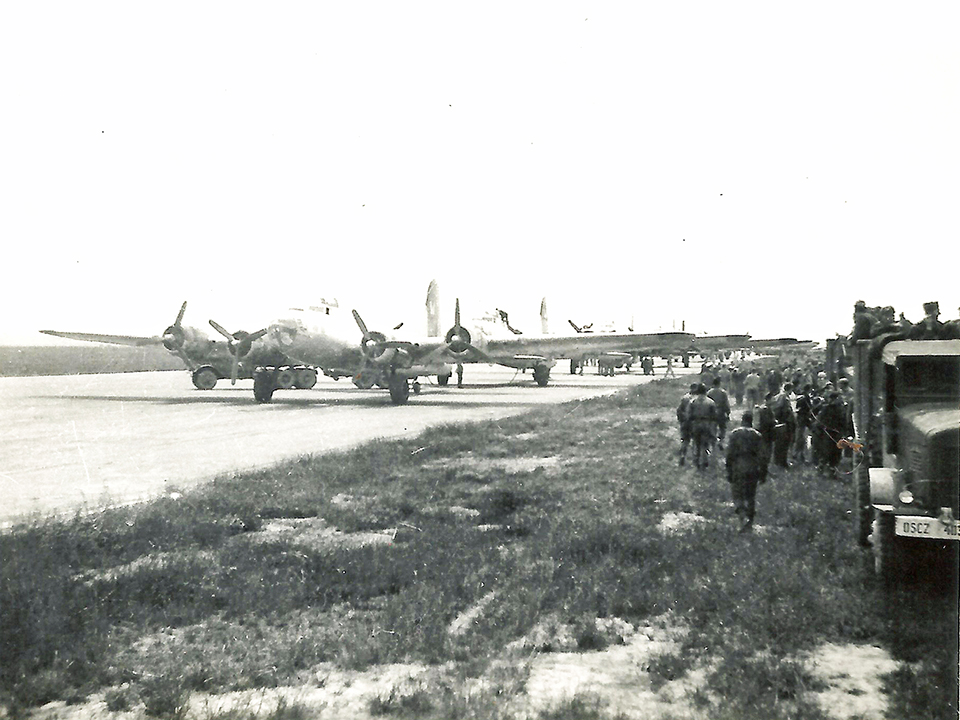


![Max Fuchs, New York City cantor, sings as Rabbi Sydney [sic] Lefkowitz, Richmond, VA, conducts the first Jewish services from Germany.](/sites/default/files/styles/max_650x650/public/2025-10/image1.jpg)




